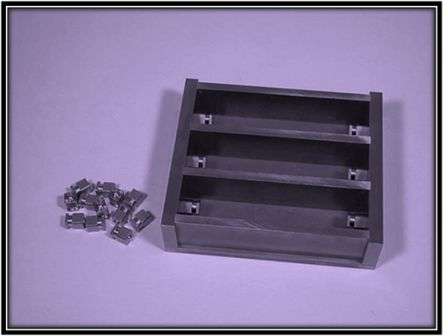Objective
For determination of Drying shrinkage of Pozzolanic materials.
Reference standards
IS : 1727- 1967 Methods of test for Pozzolanic : Determination of Drying shrinkage in pozzolana-cement mortar.
Equipment & Apparatus
- Scale
- Trowel
- Length Comparator
- Flow Table
Procedure
- The moulds shall be thinly covered with mineral oil; after this operation the stainless steel or non-corroding metal reference points shall be set, care being taken to keep them clean and free of oil.
- Mould shall then be set on plane, non-absorbent base plates that have been thinly coated with mineral oil.
- The dry materials of the standard test mortar shall be Pozzolana : Cement : standard sand in proportion 0.2 N : 0.8 : 3.
Where
N = Specific gravity of pozzolana / Specific gravity of cement
- The amount of water for gauging shall be equal to that required to give a flow between 100 and 115 percent with 25 drops in 15 seconds.
- The following quantities of materials are suggested for preparation of mortar:
-
MATERIAL AMOUNT Pozzolana 60 x N g Cement 240 g Standard sand 900 g
- Place the dry paddle & the dry bowl in the mixing position in the mixer, then place all the mixing water in the bowl.
- Add the pozzolanic mixture to the water, then start the mixer & mix at the slow speed (140±5 rev/min) for 30 seconds.
- At that time add the entire quantity of sand slowly over a period of 30 seconds & stop the mixer, change to medium speed (285±10 rev/min) for 30 seconds.
- Stop the mixer, quickly scrape down into the batch any mortar that may have collected on the side of the bowl, then finish by mixing for one minute at medium speed (285±10 rev/min)
- Upon the completion of mixing the mixing paddle shall be shaken to remove excess mortar into the mixing bowl.
- After mixing , the test specimen shall be moulded in two layers, each layer being compacted with the thumbs and forefingers by pressing the mortar into the corners, around the reference inserts and along the surfaces of the moulds until a homogeneous specimen is obtained.
- After the top layer has been compacted, the mortar shall be leveled off flush with the top of the mould and the surface smoothed with a few strokes of the trowel. During the operations of mixing and moulding, the hands shall be protected by rubber gloves.
- After filling the moulds, place them immediately in a moist room or moist closet for 24±2 hours.
- Then remove the specimens from the moulds and immediately immerse in water at 27 ± 20 C and allow them to remain there for six days.
- Remove the specimens from the water and measure for length using a length comparator. Protect specimens against loss of moisture prior to reading for initial length.
- The temperature of the test specimens at the time of initial measurement shall be 27 ± 20 C (temp.- 27 ± 20 C, Humidity- 50±5 %).
- Measure the length of the specimens again 28 days after the initial measurement.
- Place the specimens in the comparator with the same end uppermost with respect to the position of the specimens as when the initial measurement was made.
- When making the measurements, the specimens, comparator, and the reference bar shall be at a temperature of 27±20 C.
Calculation
Calculate the average difference in length of the three specimens to the nearest 0.01 percent of the effective gauge length, and report this difference as the drying shrinkage.
Safety & Precautions
- Use hand gloves while removing containers from oven after switching off the oven.
